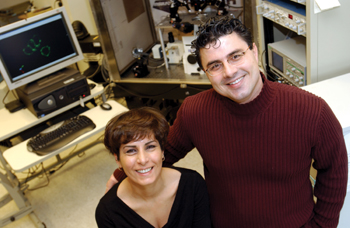
Habibeh Khoshbouei, Ph.D., a research instructor, and Aureilo Galli, Ph.D., assistant professor of Molecular Physiology and Biophysics, are studying how amphetamines alter brain function. Photo by Dana Johnson
Team study illuminates 'speed' action
A multi-institutional team of neuroscientists led by Aurelio Galli, Ph.D., at Vanderbilt University and Jonathan Javitch, M.D., Ph.D., at Columbia University has clarified the action of an increasingly popular drug of abuse — amphetamine.
The findings, published this month in the journal Public Library of Science Biology, could lead to new strategies for the treatment of substance abuse and psychiatric disorders.
Scientists have known for some time that amphetamines, cocaine and other psychostimulant drugs act on a family of proteins called neurotransmitter transporters, particularly those that move the chemical dopamine. Transporters stud the surface of nerve cell terminals and normally act like molecular vacuum cleaners, sweeping released chemical messengers back into the nerve terminal. They are critical to normal communication in the brain.
Galli and Javitch have teamed up in the past to show that dopamine transporters redistribute in response to amphetamine, leading to fewer transporters present on the neuronal cell surface. This redistribution, and competition between amphetamine and dopamine for transport, means that the dopamine transporter no longer efficiently clears dopamine from the synapse when amphetamine is present. In addition, the transporter moves dopamine out of the nerve cell.
The resulting overload of synaptic dopamine enhances mood and body movement and plays an important role in the addictive properties of psychostimulants.
“No one has understood how amphetamine causes dopamine efflux from the neuron,” said Galli, assistant professor of Molecular Physiology & Biophysics. Based on earlier findings, Galli and Javitch, along with Margaret Gnegy at the University of Michigan, hypothesized that a chemical modification — called phosphorylation — of the dopamine transporter protein was involved in mediating the amphetamine-induced dopamine release.
The current studies suggest they are correct. The dopamine transporter has a “tail” segment, which includes amino acids that can be phosphorylated. When this tail is removed, or the amino acids are changed so that they cannot be modified, amphetamine no longer induces dopamine efflux. Surprisingly, the altered transporters can still move dopamine into the cell, Galli said.
“We are really excited about these findings, because for the first time we can modulate dopamine efflux without affecting influx,” he said. Discriminating the two is important, he said, because dopamine efflux is associated with the abuse potential of amphetamines.
“We wanted to identify a way to block the dopamine efflux, without interfering with the normal physiological reuptake function of the transporter,” Galli said. “We think we’ve identified a region of the transporter molecule that is of real importance for amphetamine action. It might be a good target for new therapeutic agents that block the effects of amphetamine-like psychostimulants.”
The findings are not just about amphetamine action, Galli said. “Our studies reveal basic mechanisms of how the transporter works and suggest ways that we can modulate the level of neurotransmitter extracellularly (outside the neuron).”
And because neurotransmitter transporters are the molecular targets not only of drugs of abuse, but also of medicines used to treat depression and ADHD, future drug development for these psychiatric disorders depends on a full understanding of how these proteins work, Galli said. In addition, he said, a genetic mutation of the dopamine transporter tail region that alters efflux could be associated with human psychiatric or neurologic dysfunction.
Habibeh Khoshbouei, an instructor in Galli’s laboratory, and Namita Sen, a research scientist in Javitch’s laboratory, are co-first authors of the paper in PLoS Biology, a new journal launched in October 2003 by an organization of scientists and physicians committed to making the world’s scientific literature freely available to the public. The journal is accessible online at http://biology.plosjournals.org.
Other co-authors include Gnegy, Bipasha Guptaroy, L’Aurelle Johnson, and David Lund at the University of Michigan. The research was supported by the National Institutes of Health.













